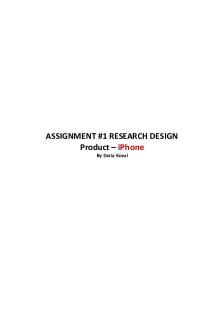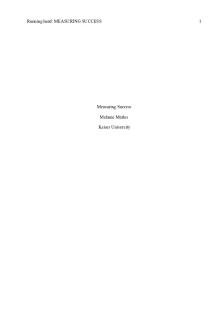Quantresearch - quant research assignment PDF

| Title | Quantresearch - quant research assignment |
|---|---|
| Author | Stacey Orsini |
| Course | Understanding Nursing Research |
| Institution | Keiser University |
| Pages | 2 |
| File Size | 88.2 KB |
| File Type | |
| Total Downloads | 17 |
| Total Views | 147 |
Summary
quant research assignment...
Description
Assignment: Quantitative Research
Name: Stacey Orsini
From a well-designed abstract the researcher may be able to identify if the research is a study that can be used as evidence to address the problem being examined. The following questions are important in conducting an initial critical appraisal of a quantitative research report. 1. How many questions can you answer based on the abstract? 10 2. What type of quantitative study was conducted: descriptive, correlational, quasi-experimental, or experimental? descriptive quantitative design 3. Can you identify the following sections in the research report: Introduction, Methods, Results, and Discussion? Yes 4. Were the steps of the study clearly identified? Yes Fig. 2.2, p. 39 identifies the steps of the quantitative research process (counterclockwise). Identify each element below. In your response, for each item, please include where you found that information (which major section – Introduction, Methods, Results, or Discussion), and for those that are bolded also include what the author describes. A. Research problem and purpose: Introduction; Requirements for Patient Safety suggest that students encounter patients well prepared. In clinical laboratory practice (CLP), the students simulate patient situations as a preparation for internship. Various CLP models have been tried out to meet the students’ prerequisites and learning strategies. B. Review of literature: Introduction C. Study framework: Objectives; The purpose of this study was to try out two different learning sessions related to the bed bath procedure D. Research question or hypothesis: Objectives; (1) To investigate the students degree of satisfaction with the learning session's organization and relevance before and after practice. (2) To compare the perceptions of the project group and the control group. (3) To compare perceptions of students with different age, with and without previous clinical experience and with unequal extent of training. (4) To explore whether there are correlations between the perceptions before and after the clinical practice. E. Study variables: Objectives; different ages with or without clinical experience, and with unequal extent of training. F. Study design: Methods G. Population and sample: Methods; Population of 160 students randomly divided into two classes, Class 1 (N= 79) and Class 2 (N=81) Class 1 in the control group, Class 2 is the project group. Each class divided in half so total was held in four training sessions.
H. Measurement methods: Methods I. Data collection: Methods J. Data analysis: Methods K. Discussion of research outcomes: Discussion
5. Were any of the steps of the research process missing? No, all steps were included....
Similar Free PDFs

Quant Cheatsheet
- 9 Pages

Quant - HW
- 1 Pages

Quant trading - sdg
- 204 Pages

Research Outline - ASSIGNMENT
- 4 Pages

Assignment 1 research design
- 6 Pages

Admin Research Assignment
- 12 Pages

Assignment 1 - Research based
- 8 Pages

Market Research - Assignment 3
- 37 Pages

Research methodology assignment
- 10 Pages

Formal Research Assignment
- 10 Pages

Research Assignment - 6/7
- 5 Pages

Tennents Research for Assignment
- 12 Pages
Popular Institutions
- Tinajero National High School - Annex
- Politeknik Caltex Riau
- Yokohama City University
- SGT University
- University of Al-Qadisiyah
- Divine Word College of Vigan
- Techniek College Rotterdam
- Universidade de Santiago
- Universiti Teknologi MARA Cawangan Johor Kampus Pasir Gudang
- Poltekkes Kemenkes Yogyakarta
- Baguio City National High School
- Colegio san marcos
- preparatoria uno
- Centro de Bachillerato Tecnológico Industrial y de Servicios No. 107
- Dalian Maritime University
- Quang Trung Secondary School
- Colegio Tecnológico en Informática
- Corporación Regional de Educación Superior
- Grupo CEDVA
- Dar Al Uloom University
- Centro de Estudios Preuniversitarios de la Universidad Nacional de Ingeniería
- 上智大学
- Aakash International School, Nuna Majara
- San Felipe Neri Catholic School
- Kang Chiao International School - New Taipei City
- Misamis Occidental National High School
- Institución Educativa Escuela Normal Juan Ladrilleros
- Kolehiyo ng Pantukan
- Batanes State College
- Instituto Continental
- Sekolah Menengah Kejuruan Kesehatan Kaltara (Tarakan)
- Colegio de La Inmaculada Concepcion - Cebu



![[Creswell, J.] Research design Qualitative, Quant(b-ok.xyz) FOURTH ED](https://pdfedu.com/img/crop/172x258/53x4l84qmr12.jpg)